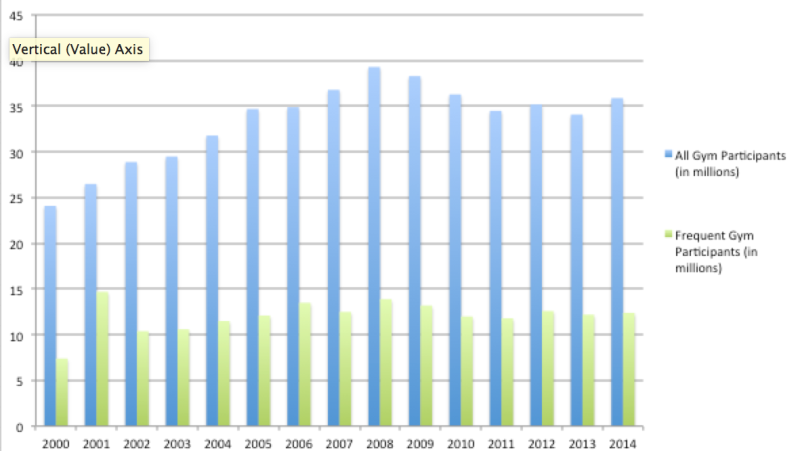The "gym trend" has shown remarkable growth over the last decade and is expected to continue grow over the course of the next few years. But why has America, the land of fast food junkies and couch potatoes, suddenly taken interest in the world of fitness? Is it because we’ve finally grasped the epidemic of obesity and heart disease plaguing our nation? Or is it because we want our bodies to look at their prime for all our Instagram posts in the near future? The answer is yes.
Statistics Tell the Story
The total number of US gym participants per year has increased from 24.1 million people in 2000 to 35.9 million people in the last couple years, and this number continues to escalate. Additionally, the number of frequent gym participants, or members who go to the gym 110 days a year or more, has shot up from 8 million to 12.4 million in that same time span. The explanation for these stats is multifaceted. One reason is that Americans are finally realizing how serious obesity, heart disease, and diabetes.

Perhaps the younger generations have better heads on their shoulders when it relates to personal health. The Boston Globe suggests that this is turning around negative health statistics because the baby boomer generation was “a generation convinced of its indestructibility but prone to ignoring well-meaning advice — including the recommended amount of exercise they should get every week.”
There comes a certain point where Americans have so many of their family members and friends suffer and even die as a result of bad health decisions that they have no choice but to wake up and act upon the reality of their health conditions. The era of invincibility coming to an end is a major factor behind the growth of the fitness industry.
The Impact of Social Media
Social media and entertainment images are equally pivotal in advancing the fitness movement. Not only do we now have access data, ideas, new exercises, workout trends, and calorie trackers at our fingertips, but the desire for a beautiful body is at an all time high as pictures of individuals showing off their bodies flood networks like Facebook, Twitter, and Instagram. Also, all this technology has created a world of instant gratification, so people want results and they want them now.
Eric Stevens, a fitness coach and author on Breaking Muscle blog, says, “Technology as a whole is neither good nor bad - it’s both. The key is having the self-awareness to decipher how technology is affecting us.”
Another driving factor in growing the fitness industry is the emergence of CrossFit, which has basically become a sport of its own. CrossFit workouts combine weightlifting and cardio in a unique way that can be defined as “functional movements that are constantly varied at high intensity.” This workout method has caught on like wildfire because it produces results and simultaneously creates a sense of community among the people who do these workouts together. Crossfit competitions have even made their way onto national sports networks including ESPN and Fox Sports.
America has finally realized that the fitness industry creates a wonderful escape from the business of daily life and the health benefits from participating in this industry are immaculate. Not everyone can play a sport, but everyone can workout. Perhaps the growth of the fitness industry is more than just a fad.
This article was written by Jordan Hovater, a Marketing and Finance student in Samford University’s Brock School of Business. Follow him on Twitter @HovaterSports.
Works Cited
Stevens, Eric C. "Social Media and Fitness: The Good, the Bad, and the Ugly." Breaking Muscle. N.p., n.d. Web. 18 Oct. 2015.
Weisman, Robert. "Exercise Goals Are Increasing but Most Americans Still Do Not Work out Enough - The Boston Globe." BostonGlobe.com. N.p., 14 Apr. 2013. Web. 15 Oct. 2015.
Data and Excel sheet are from the Sports Business Research Network
